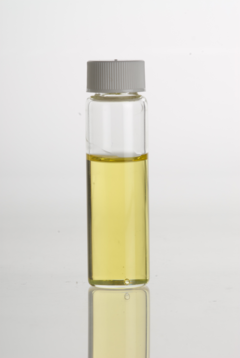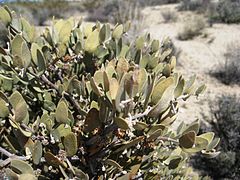Benutzer:Caropik/Jojobaöl
Wenn du dies liest:
|
Wenn du diesen Artikel überarbeitest:
|
Jojoba oil Vorlage:IPAc-en is the liquid produced in the seed of the Simmondsia chinensis (Jojoba) plant, a shrub, which is native to southern Arizona, southern California, and northwestern Mexico. The oil makes up approximately 50% of the jojoba seed by weight.[1] The terms "jojoba oil" and "jojoba wax" are often used interchangeably because the wax visually appears to be a mobile oil, but as a wax it is composed almost entirely (~97%) of mono-esters of long-chain fatty acids and alcohols, accompanied by only a tiny fraction of triglyceride esters. This composition accounts for its extreme shelf-life stability and extraordinary resistance to high temperatures, compared with true vegetable oils.
History
Native Americans extracted the oil from jojoba seeds to treat sores and wounds. The collection and processing of the seed from naturally occurring stands marked the beginning of jojoba domestication in the early 1970s.[2]
In 1943, natural resources of the U.S, including jojoba oil, were used during war as additives to motor oil, transmission oil and differential gear oil. Machine guns were lubricated and maintained with jojoba.[3]
Appearance
Unrefined jojoba oil appears as a clear golden liquid at room temperature with a slightly nutty odor. Refined jojoba oil is colorless and odorless. The melting point of jojoba oil is approximately 10 °C[4] and the iodine value is approximately 80.[5] Jojoba oil is relatively shelf-stable when compared with other vegetable oils mainly because it contains little triglycerides, unlike most other vegetable oils such as grape seed oil and coconut oil.[6] It has an oxidative stability index of approximately 60,[7] which means that it is more shelf-stable than safflower oil, canola oil, almond oil or squalene but less than castor oil and coconut oil.
Chemistry
| freezing point | 7-10.6 °C[8][9] |
| refractive index | 1.4650 at 25 °C[8] |
| specific gravity | 0.863 at 25 °C[8] |
| smoke point | 195 °C[9] |
| flash point | 295 °C[8] |
| iodine number | 82[8] |
| viscosity | 48 SUS at 99 °C[9]
127 SUS at 37.8 °C[9] |
| viscosity index | 190-230[10] |
Fatty acids present in jojoba oil[11]
| Fatty acid | Carbon atoms:double bonds | double bond positions | Percentage (mole fraction) |
| Palmitic acid | C16:0 | - | 0.3 |
| Palmitoleic acid | C16:1 | 9 | 0.3 |
| Stearic acid | C18:0 | - | 0.2 |
| Oleic acid | C18:1 | 9 | 9.3 |
| Arachidic acid | C20:0 | - | - |
| 11-Eicosenoic acid | C20:1 | 11 | 76.7 |
| Behenic acid | C22:0 | - | trace |
| Erucic acid | C22:1 | 13 | 12.1 |
| Lignoceric acid | C24:0 | - | 0.1 |
| Nervonic acid | C24:1 | 15 | 1.0 |
The fatty acid content of Jojoba oil can vary significantly depending on the soil and climate in which the plant is grown, as well as when it is harvested and how the oil is processed. In general it contains a high proportion of mono-unsaturated fatty acids, primarily 11-Eicosenoic acid (Gondoic acid).
Uses
Jojoba oil is used as a replacement for whale oil and its derivatives, such as cetyl alcohol. The ban on importing whale oil to the U.S. in 1971 led to the discovery that jojoba oil is "in many regards superior to sperm whale oil for applications in the cosmetics and other industries."[1]
Jojoba oil is found as an additive in many cosmetic products, especially those marketed as being made from natural ingredients. In particular, such products commonly containing jojoba are lotions and moisturizers, hair shampoos and conditioners. The pure oil itself may also be used on skin, hair, or cuticles.[12][13]
Jojoba oil is a fungicide, and can be used for controlling mildew.[14]
Like olestra, jojoba oil is edible but non-caloric and non-digestible, meaning the oil will pass out of the intestines unchanged and can cause a stool condition called steatorrhea. It also contains approximately 12.1% of the fatty acid Erucic acid that would appear to have toxic effects on the heart at high enough doses (were it digestible).[15]
Jojoba biodiesel has been explored as a cheap, sustainable fuel that can serve as a substitute for petroleum diesel.[16]
See also
Photo gallery
References
External links
: Jojoba: A unique liquid wax producer from the American desert. In: Advances in new crops . Timber Press, Portland, OR, 1990, S. 247–251..
- Description and chemical structure of jojoba oil
- Can This Unassuming Little Desert Shrub Really Save The World? - The first article from 1977
- ↑ a b Jojoba. In: Alternative Field Crops Manual. 1990.
- ↑ Jojoba. In: hort.purdue.edu . Abgerufen am 17. April 2016.
- ↑ Howard Scott Gentry: The Natural History of Jojoba (Simmondsia chinensis) and Its Cultural Aspects. In: Economic Botany. 12, Nr. 3, 1. Januar 1958, S. 261–295. doi:10.1007/bf02859772.
- ↑ AOCS Method Cc 18-80. Archiviert vom Original am 13. März 2007. Abgerufen am 13. Oktober 2006.
- ↑ AOCS Method Cd 1-25. Abgerufen am 13. Oktober 2006.
- ↑ "Learn the powerful benefits of jojoba oil". Retrieved 2011-07-01.
- ↑ AOCS Method Cd 12b-92. Abgerufen am 13. Oktober 2006.
- ↑ a b c d e Jaime Wisniak. The chemistry and technology of jojoba oil. Page 24
- ↑ a b c d Nasir El Bassam (1998). Energy Plant Species: Their Use and Impact on Environment and Development. pg 168
- ↑ I. J. Heilweil. Review of Lubricant Properties of Jojoba Oil and its Derivatives.
- ↑ J. Busson-Breysse, M. Farines, J. Soulier: Jojoba wax: Its esters and some of its minor components. In: Journal of the American Oil Chemist' Society. 71, Nr. 9, 1994, ISSN 0003-021X, S. 999–1002. doi:10.1007/BF02542268.
- ↑ Jojoba Oil for Nails: Natural Care for Your Perfect Manicure. In: Body (personal) care. Oily Oily. Abgerufen im 29 August 2013.
- ↑ Maggie Lynn: Jojoba Oil Benefits. Livestrong. 20 March 2011. Abgerufen im 29 August 2013.
- ↑ Fehlender Parameter „Land“ und „V-Nr“
- ↑ A. R. Place: Comparative aspects of lipid digestion and absorption: physiological correlates of wax ester digestion. (abstract) In: American Journal of Physiology. Regulatory, Integrative and Comparative Physiology. 263, Nr. 3, September 1, 1992, S. 464–R471. PMID 1415629. Abgerufen am 17. März 2008.
- ↑ Jojoba oil could fuel cars and trucks. New Scientist. March 6, 2003. Abgerufen am 13. Oktober 2006.





